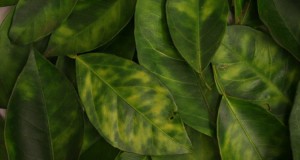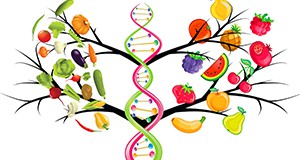
This field sheet provides information on Tap sampling for Asian Citrus Psyllid (ACP). Monitoring ACP populations is an important tool in the integrated management of citrus greening. The most efficient way to estimate field populations of this insect is by monitoring adults. Tap sampling has proven to provide data needed to make informed decisions for managing this insect pest. This two-page field sheet is the Spanish version of IN1116 TAP Sampling for Asian Citrus Psyllid (ACP) Field Sheet. Written by Phil Stansly, and published by the Entomology and Nematology Department.
http://edis.ifas.ufl.edu/in1122
Category: Citrus
Cost of Production for Processed Oranges in Central Florida (Ridge), 2014/15
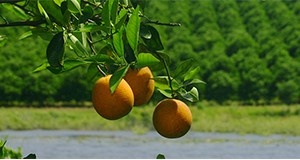
UF/IFAS researchers collected data from five growers to estimate the cost of production per acre for processed oranges in central Florida during 2014/15. The cost estimates in this 4-page fact sheet written by Ariel Singerman and published by the Food and Resource Economics Department do not represent any individual operation. Instead, their purpose is to serve as a benchmark for the Florida citrus industry. Typical users of these estimates include growers, consultants, property appraisers, and researchers.
http://edis.ifas.ufl.edu/fe985
Cost of Production for Fresh Grapefruit in East Florida (Indian River), 2014/15
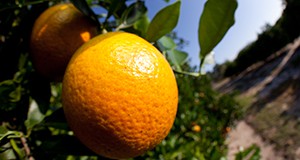
This 4-page article written by Ariel Singerman and published by the Food and Resource Economics Department presents the cost of production per acre for growing fresh grapefruit in the Indian River region during 2014/15, based on a survey of growers conducted at the Indian River Citrus League production committee meeting in March 2015. The cost estimates do not represent any individual operation; rather, their purpose is to serve as a benchmark for the industry. Typical users of these estimates include growers, consultants, property appraisers, and researchers.
edis.ifas.ufl.edu/FE984
Impact of Citrus Greening on Citrus Operations in Florida
Florida is the largest orange-producing state in the United States and the third largest orange producer in the world, but the Florida citrus industry and its position in the global citrus market are being jeopardized by a bacterial disease known as citrus greening or Huanglongbing (HLB). HLB hurts the vascular systems of citrus trees and prevents them from absorbing nutrients. The disease reduces yields, leads to smaller, lower-quality fruit, kills trees, and increases farmers’ production costs. First found in Florida in 2005, HLB has spread rapidly across the state.
As of January 2016, there is neither a cure nor an economically viable option for managing HLB-infected trees. Since HLB was first found in 2005, orange acreage and yield in Florida have decreased by 26% and 42%, respectively. Orange production dropped from 242 million to 104.6 million boxes in 2014. Even though the industry acknowledges that HLB has reached epidemic proportions across the state, estimates of the level of infection and its impact on citrus operations are scarce. This 4-page article written by Ariel Singerman and Pilar Useche and published by the Food and Resource Economics Department presents the first growers’-survey-based estimates of both the level of HLB infection in Florida and the impact of HLB on citrus operations in Florida.
http://edis.ifas.ufl.edu/fe983
Suggested Weed Control Programs for Citrus

Weed management is an important component of citrus production. The selection and implementation of a weed management program can lead to both economic and environmental returns. This three-page fact sheet details how to manage weeds in both young and mature groves, the differences in weed control programs between interior areas and coastal or flatwoods areas, how to control weeds after a freeze, and common ways that herbicides are misused. Written by Stephen H. Futch and Brent Sellers, and published by the Horticultural Sciences Department.
http://edis.ifas.ufl.edu/ch084
2014/15 Picking, Roadsiding, and Hauling Charges for Florida Citrus
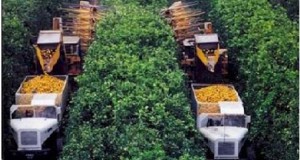
As Florida’s citrus industry confronts the impacts of Huanglongbing (HLB or citrus greening)–decreasing crop yields and production, lower quality fruit, and increasing cost of production–many growers are facing declining returns. A 2015 survey of twelve Florida citrus harvesters to collect data on harvesting charges during the 2014/15 season revealed that average picking and roadsiding charges for fresh fruit are in most cases lower than those for processed fruit, likely because of the impact of HLB. This 3-page fact sheet written by Ariel Singerman of UF/IFAS Citrus Research and Education Center and published by the Food and Resource Economics Department presents the results of the survey and provides a table summarizing the harvesting charges for citrus during the 2014/15 season with the average and the range of picking and roadsiding charges by variety and type of fruit (fresh versus processed), as well as the average hauling charges for all varieties by distance. The fact sheet will assist growers in the effort to compute the changes to their economic returns as the industry adapts to remain profitable.
http://edis.ifas.ufl.edu/fe977
Freeze Damage Symptoms and Recovery for Citrus

Citrus trees are evergreen, never become fully dormant, and cannot withstand temperatures as low as those tolerated by deciduous trees. But citrus trees can become preconditioned or acclimated to cool air temperatures that occur in late fall and winter. One of the best ways to lessen cold injury and to hasten recovery from cold damage is to maintain healthy trees. This five-page fact sheet discusses the symptoms of freeze damage and ways to help recover trees that have been damaged. Written by Mongi Zekri, Chris Oswalt, Steve Futch, Gary England, Camilly McAvoy, Laurie Hurner, and Parker Platts, and published by the Horticultural Sciences Department.
http://edis.ifas.ufl.edu/hs1250
Citrus Reset Management

Replacement of dead and diseased trees in Florida citrus groves has always been an important part of citrus production. Today, tree replacement is more important than ever since overhead and production costs are escalating and a full stand of productive trees is essential to maximize production and profits. In more recent times, Huanglongbing (HLB), or citrus greening, has accelerated tree loss rates as well as the ability for growers to bring young citrus trees into production. This five-page fact sheet discusses a wide range of techniques for providing young tree care. Many of these should prove useful to Florida citrus growers confronted with the problem of managing resets. Written by Stephen H. Futch, and published by the Horticultural Sciences Department.
http://edis.ifas.ufl.edu/ch025
What Is the Economic Benefit of a Citrus Health Management Area? A Case Study

A Citrus Health Management Area (CHMA) is a group of growers who work cooperatively to coordinate insecticide application timing and mode of action in order control the insect vector of citrus greening disease. CHMAs help prevent insect vectors from moving between groves and reduce the likelihood that insects will develop pesticide resistance. This 3-page fact sheet written by Ariel Singerman and Brandon Page and published by the Food and Resource Economics Department analyzes the case-study data on yields of Valencia oranges from blocks located in two different categories of CHMAs to find the impact of citrus greening disease on citrus yields and provide evidence on the effectiveness of best class CHMAs as a way to deal with the disease. The analysis provides evidence that CHMAs can enhance an individual grower’s profitability at a time when margins are becoming increasingly narrow.
edis.ifas.ufl.edu/fe982
Phytophtora Management in Citrus Nurseries
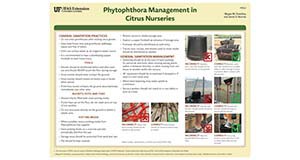
Check out the new fact sheet about Phytopthora Management in Citrus Nurseries. A great on-hand resource, this fact sheet covers sanitation practices, tools, and potting media for citrus nurseries. It also illustrates correct and incorrect practices and provides information about disinfectants and chemicals to use. Written by Megan M. Dewdney and Jamie D. Burrow, and published by the Plant Pathology Department.
http://edis.ifas.ufl.edu/pp322
Dooryard Citrus Production: Asiatic Citrus Canker Disease
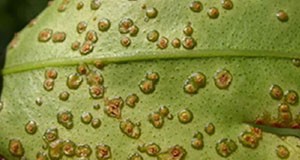
Asiatic citrus canker is a bacterial disease of citrus that causes necrotic lesions on leaves, stems, and fruit of infected trees. Severe cases can cause defoliation, premature fruit drop, twig dieback, and general tree decline.This eight-page fact sheet explains the history of citrus canker in Florida, describes the symptoms of citrus canker, and details how to manage the spread of citrus canker disease by preventing infection and controlling existing infections. Written by Megan M. Dewdney, Jamie D. Burrow, James H. Graham, Timothy M. Spann, and Ryan A. Atwood, and published by the Horticultural Sciences department.
http://edis.ifas.ufl.edu/pp323
TAP Sampling for Asian Citrus Psyllid (ACP) Field Sheet

This new field sheet provides information on Tap sampling for Asian Citrus Psyllid (ACP). Monitoring ACP populations is an important tool in the integrated management of citrus greening. The most efficient way to estimate field populations of this insect is by monitoring adults. Tap sampling has proven to provide data needed to make informed decisions for managing this insect pest. Written by Phil Stansly, and published by the Entomology and Nematology Department.
http://edis.ifas.ufl.edu/in1116
Cost of Production for Processed Oranges in Southwest Florida, 2014/15

UF/IFAS researchers collected data from twelve growers to estimate the cost of production per acre for processed oranges in southwest Florida during 2014/15. The cost estimates in this 4-page fact sheet written by Ariel Singerman and published by the Food and Resource Economics Department do not represent any individual operation. Instead, their purpose is to serve as a benchmark for the Florida citrus industry. Typical users of these estimates include growers, consultants, property appraisers, and researchers.
http://edis.ifas.ufl.edu/fe986
Pest Identification Guide: An Introduction to Thrips
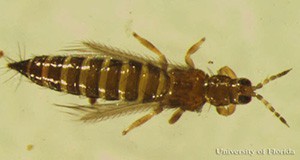 Tiny insects called thrips are difficult to see with the unaided eye but cause very obvious and sometimes ruinous damage to the flowers, buds, and fruit of many important crops. This two-page guide asks and answers the key thrips questions that allow growers to distinguish between chilli thrips, common blossom thrips, and Western flower thrips to more effectively battle against these destructive pests. What does it look like? What is its life cycle? Where is it found? What type of damage does it cause? And, most importantly, who are its natural enemies? Use this guide to help you identify thrips so that you can take effective steps to control them and limit the damage they cause. Written by Nicole Casuso and Hugh Smith with photos by Lyle Buss, Jeff Cluever, Vivek Kumar, P.M.J. Ramakers, Gary Vallad, and Hugh Smith. Published by the Entomology and Nematology Department, UF/IFAS Extension.
Tiny insects called thrips are difficult to see with the unaided eye but cause very obvious and sometimes ruinous damage to the flowers, buds, and fruit of many important crops. This two-page guide asks and answers the key thrips questions that allow growers to distinguish between chilli thrips, common blossom thrips, and Western flower thrips to more effectively battle against these destructive pests. What does it look like? What is its life cycle? Where is it found? What type of damage does it cause? And, most importantly, who are its natural enemies? Use this guide to help you identify thrips so that you can take effective steps to control them and limit the damage they cause. Written by Nicole Casuso and Hugh Smith with photos by Lyle Buss, Jeff Cluever, Vivek Kumar, P.M.J. Ramakers, Gary Vallad, and Hugh Smith. Published by the Entomology and Nematology Department, UF/IFAS Extension.
http://edis.ifas.ufl.edu/in1058
Maximizing Weed Control in Florida Citrus

With Florida citrus growers and production managers being “squeezed” between rising production prices and declining yields from citrus greening, there’s more call than ever to reduce citrus production costs. Controlling weeds is a major expense, amounting to 11% of the total $2,278 annual production cost per acre for the 2014–2015 season. This 3-page fact sheet teaches the six essential components of an effective weed-management program to help maintain the profitability of this vital Florida industry. Written by Stephen H. Futch and Brent Sellers and published by the Horticultural Sciences Department. http://edis.ifas.ufl.edu/hs237
Mechanical Pruning of Citrus Trees

When citrus trees are not regularly pruned, less sunlight reaches the lower parts of the trees, which can reduce flowering and fruit development, quality, and color. Less sunlight also increases the risk of fungal infection. This 3-page fact sheets explains how growers can prune trees to maximize light exposure. Written by Mongi Zekri, and published by the UF Department of Horticultural Sciences, August 2015.
http://edis.ifas.ufl.edu/hs1267
Flatwoods Citrus Best Management Practice: Riser-Board Structures
 Water discharge structures are used to control water table levels and surface water levels in drainage and irrigation ditches within flatwoods citrus groves. The type of structure selected can significantly influence the quality of water discharged. With flashboard risers, water is forced to flow over the top board. This flow path creates a low current area toward the bottom, which facilitates the deposition of sediments and their accompanying nutrients or pesticides, essentially removing them from the discharges. Conversely, screw-gate structures do not create this dead-current zone. Since they open from the bottom, sediments are swept out along with the discharge water. Written by Chris Wilson, Liberta Scotto, Brian Boman, and Tim Gaver. Original publication date February 2002. Revised April 2012 and August 2015.
Water discharge structures are used to control water table levels and surface water levels in drainage and irrigation ditches within flatwoods citrus groves. The type of structure selected can significantly influence the quality of water discharged. With flashboard risers, water is forced to flow over the top board. This flow path creates a low current area toward the bottom, which facilitates the deposition of sediments and their accompanying nutrients or pesticides, essentially removing them from the discharges. Conversely, screw-gate structures do not create this dead-current zone. Since they open from the bottom, sediments are swept out along with the discharge water. Written by Chris Wilson, Liberta Scotto, Brian Boman, and Tim Gaver. Original publication date February 2002. Revised April 2012 and August 2015.
https://edis.ifas.ufl.edu/ss409
Flatwoods Citrus Best Management Practice: Soil Stabilization

This best management practice describes stabilization practices for erosion-prone soils within flatwoods citrus groves. Significant amounts of soil may be deposited in drainage ditches and canals because of the erosion of grove soils. These deposited soils reduce the capacity for holding and transporting water. Plus, very small soil fractions may be suspended in discharge water then settle out in slower flowing areas and destroy submerged aquatic habitats, resulting in the loss of fish, invertebrate, and plant species important for healthy ecosystems. Fortunately, a variety of slope stabilization methods are available. This publication describes considerations for using plants for stabilization, or mulch-like materials. Written by P. Chris Wilson, Liberta Scotto, Brian Boman, and Tim Gaver. Original publication date March 2002. Revised April 2012 and August 2014. Reviewed August 2015.
http://edis.ifas.ufl.edu/ss408
Resetting in Citrus Groves

To maintain the overall productivity of a citrus grove, dead or declining trees should be promptly removed and replaced with young, healthy trees, a practice known as resetting. Resetting presents many challenges for growers because young trees require more attention and care than more established trees. This 4-page fact sheet discusses effective resetting methods and maintenance for citrus. Written by Zekri Mongi, and published by the UF Department of Horticultural Sciences, August 2015.
http://edis.ifas.ufl.edu/hs1266
Plant Diagnostic Clinic and HLB Lab
The Plant Pathology program at the UF/IFAS Southwest Research and Education Center is the state and local resource for plant diagnostic services, including HLB (Huanglongbing, or citrus greening) detection, and for insect identification. This brochure covers the center’s history, instructions for sending samples to the HLB lab, answers to frequently asked questions, and center hours and contact information. Written by Pamela Roberts, Shea Teems, Joubert Fayette, and Jamie Burrow, and published by the UF Department of Plant Pathology, July 2015.
http://edis.ifas.ufl.edu/pp319
